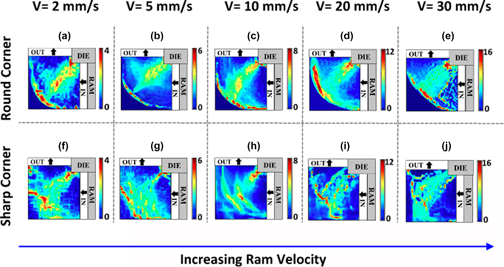Published online by Cambridge University Press: 31 March 2015

Deformation mechanics in equal channel angular pressing (ECAP) was studied in situ using digital image correlation (DIC) and infra-red (IR) thermography. In a prototypical experiment in an optical and IR transparent die, the deformation of commercially pure lead (Pb) is observed using high-speed optical and IR cameras. From the resulting time-sequence images of metal-flow in the deformation zone, DIC is used to characterize the zone of severe plastic deformation (SPD) as a function of the scale of deformation (sample dimensions), deformation speed, and die geometry. The temperature rise in the deformation zone was characterized using IR thermography and the results were compared against theoretical estimates. These observations provide direct insights into the mechanics of SPD in ECAP, which can offer strategies for microstructure control, process optimization, and miniaturization of ECAP.